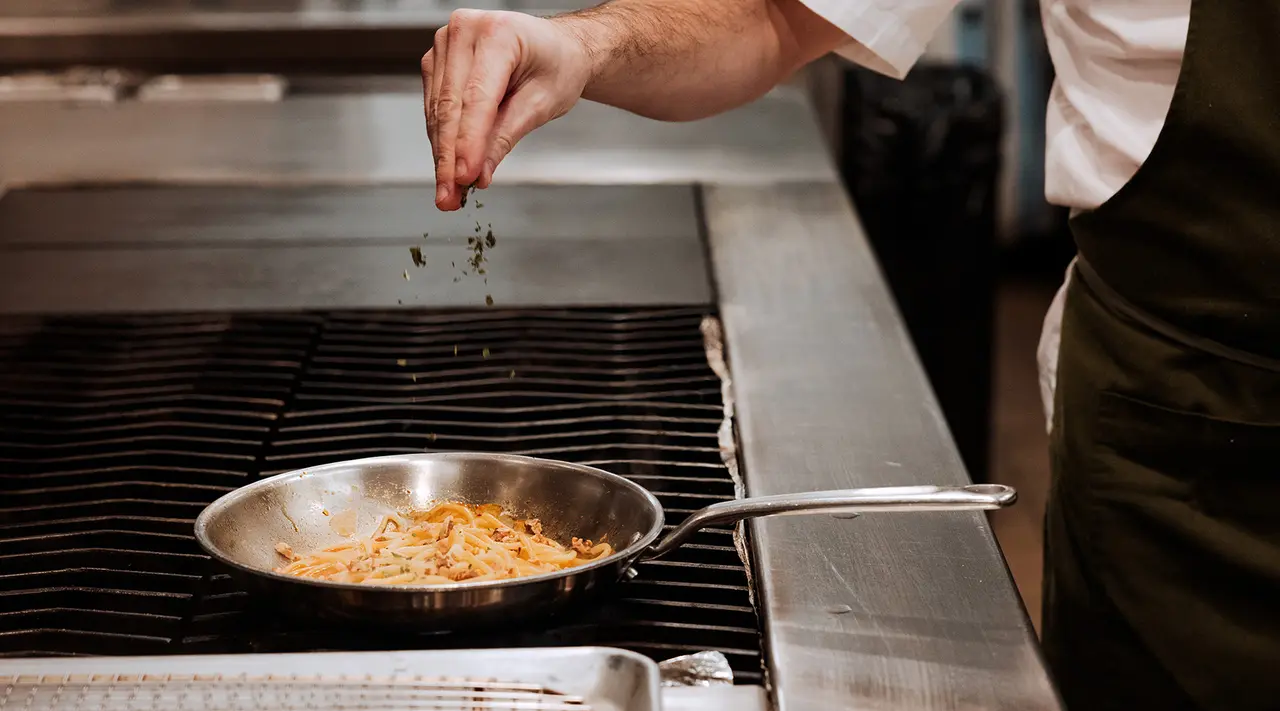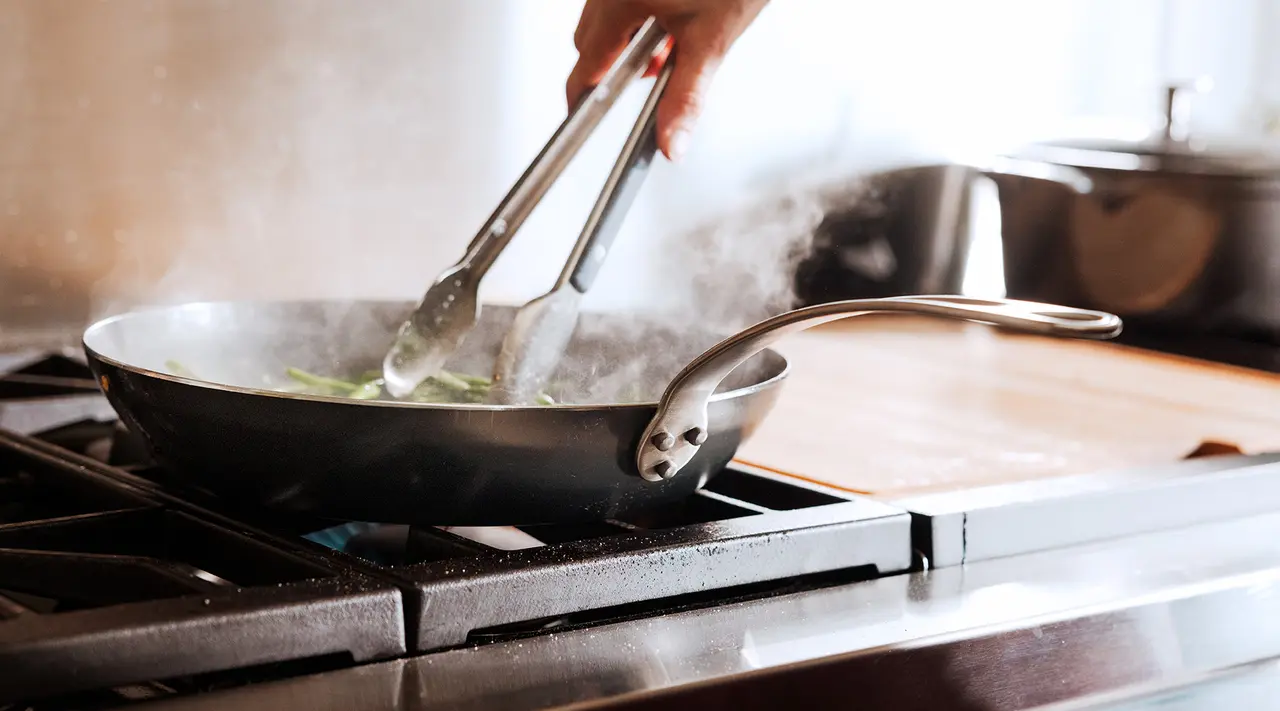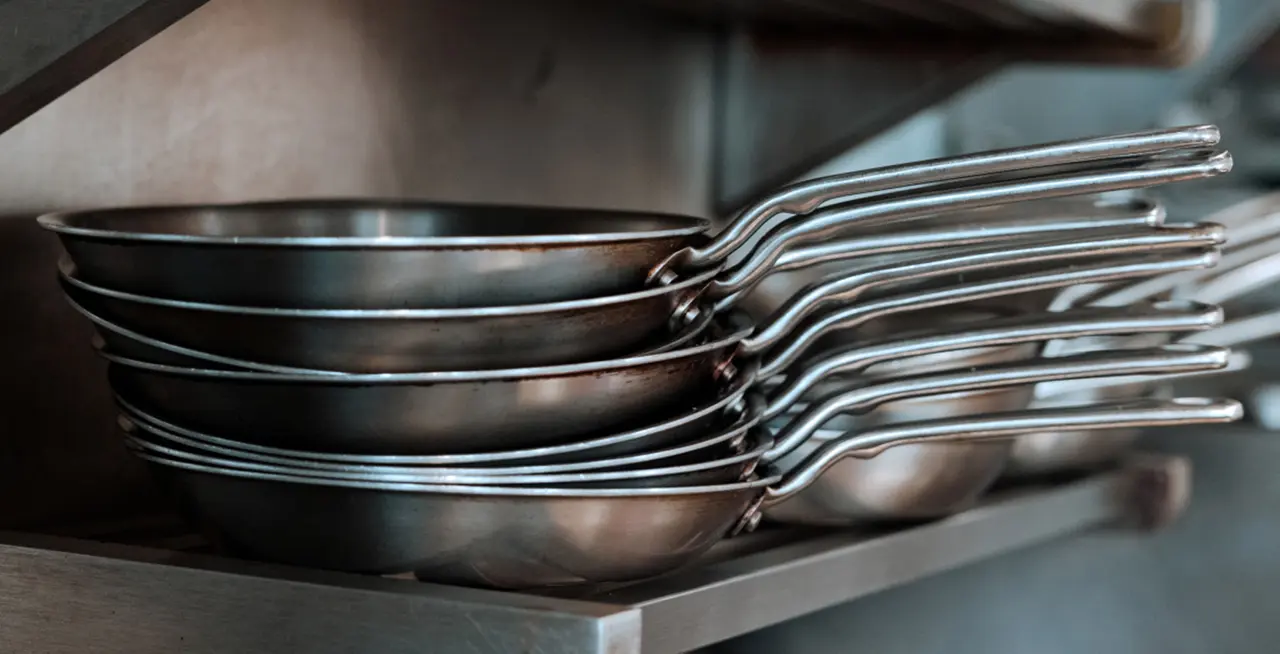The frying pan is about as ubiquitous in a home or restaurant kitchen as a cutting board, chef knife, or salt and pepper shakers. Thus, they’re pretty easy to take for granted—until you try cooking without one, that is.
A durable, well-designed frying pan opens up a world of options in the kitchen, helping you achieve consistently delicious results and an easier, more efficient cooking experience overall. Read on to find out just how much they can do.
What Is a Frying Pan?

Frying pans are thought to have originated as early as the Bronze Age in Mesopotamia, when they were made from hammered copper (the oldest known metal). Cast iron skillets—along with other cast iron cookware—became widespread around the 18th and 19th centuries as cast iron became cheaper to manufacture. They were almost completely displaced by aluminum frying pans, which were introduced by the company Griswold in the late 19th or early 20th century as aluminum production was ramping up. These days, you have your pick of frying pans in a wide range of materials, including cast iron, stainless steel, and carbon steel.
In terms of the actual shape and application of a frying pan, it might seem totally interchangeable with the sauté pan: both of these are wide, shallow pans with a flat cooking surface and a long handle, and are used for cooking methods like stir-frying, sautéing, and oven-roasting.
While the differences may seem subtle, however, a frying pan offers a couple of distinct advantages over these other varieties of pan—at least where certain recipes are concerned. The most distinguishing feature of a frying pan is the flared sides. These function a bit like a ski slope, allowing food to travel smoothly up the sides of the pan, rather than crashing into them (something that the straight-sided sauté pan is guilty of). Also, before you ask: there’s no difference—other than semantic and regional—between a frying pan and a skillet.
Exploring the Many Uses of Frying Pans

Frying pans are the most multi-use pieces of cookware we can think of. Here are all of the different ways they can fit into—and enhance—your cooking routine.
Baking
Frying pans are an excellent choice for batter-based baked goods like clafoutis, tarte tatin, and Dutch babies. If you do plan on using your pan to bake, you’ll want to choose something oven-safe, with great heat circulation and retention. For these purposes, unfinished or enameled cast iron, stainless steel, and carbon steel are all solid options, as they hold and distribute heat nicely for a relatively even bake. Just make sure that both the base and the handle of your frying pan are made from oven-safe materials.
Frying
Frying pans offer just enough depth for shallow-frying, in which the food is partially but not completely submerged in oil. Depending on the dimensions of the pan and the size of the food, you can also use them to deep fry—just make sure the pan is deep enough that you don’t risk spilling hot oil.
Oven Finishing
Many of our favorite foods—especially steaks, chops, and other thick cuts of meat—start with a quick sear before finishing in the oven (or vice versa, as in the reverse searing method). Oven finishing gives you a bit more control over the cooking process so that you don’t end up with an overcooked—or unevenly cooked—piece of protein. While you can do this with just about any pan, a frying pan also allows you to sear and baste your food before transferring it, pan and all, into the oven.
Sauces
We love a frying pan for building silky pan sauces. With their shallow depth and curved sides, frying pans offer the perfect vessel for rapidly whisking, spooning, and reducing liquid to produce a perfectly smooth, emulsified texture.
Note that acidic ingredients like tomatoes or vinegar can strip the seasoning on reactive materials like carbon steel or unfinished cast iron, and potentially alter the flavor of your food. If you’re cooking with these ingredients, we recommend using a nonreactive metal like stainless steel instead.
Sautéing
Frying pans are, counterintuitively, even better at sautéing than actual sauté pans (whose name literally translates as “to jump” in French). This is because of the aforementioned sloped sides, which, as we mentioned, allow you to more easily toss and flip foods. Plus, if you don’t own a wok, a frying pan is similarly well-suited to stir-frying.
Searing
If you plan on doing a lot of searing, a stainless steel or carbon steel frying pan truly cannot be beat. Both of these materials offer excellent heat retention and distribution, which—coupled with the frying pan’s shallow profile—help achieve the perfect amount of Maillard browning.
Why Every Kitchen Needs a Frying Pan

Whether you’re a top-notch home cook or a total novice, a good frying pan can seriously improve your experience in the kitchen.
Efficiency
The right frying pan can make your cooking experience immeasurably easier and more efficient. Not only will a solid, well-built pan heat more quickly and evenly, but it’ll also maintain a fairly steady temperature, so you won’t need to constantly monitor the flame to keep your food from burning.
Versatility
As you can see, frying pan contains near-infinite possibilities: use it to stir-fry, sauté, bake, roast, shallow fry, and more. If you’re going for a minimalist vibe in your kitchen (or don’t have much storage space), a frying pan is one tool you’ll definitely want to invest in.
Durability and Longevity
As with most pieces of cookware—but especially with something as fundamental as a frying pan—it’s important to invest in a hard-wearing, durable product. Even the best non stick frying pan won’t last more than a few years, but a quality stainless steel or carbon steel frying pan can last for decades.
Ready to Shop?
Simplest is often best—and few kitchen tools embody this idea as well as the humble frying pan. We reach for ours on a daily basis, whether we’re cooking a simple grilled cheese sandwich or a date-night duck confit.
Of course, with such an oft-used piece of cookware, you’ll want to make sure you’re getting the best: our Carbon Steel, 5-Ply Stainless Clad, and Non Stick Frying Pans provide excellent heat distribution, responsiveness, and an ergonomic design—aka, everything a frying pan should have.
























